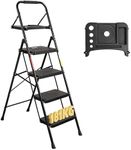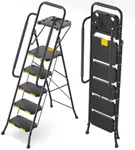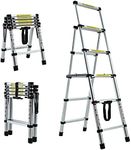Buying Guide for the Best Step Ladders
When choosing a step-ladder, it's important to consider the tasks you plan to accomplish with it, the environment in which you'll be using it, and your own physical capabilities. A step-ladder should be sturdy, safe, and appropriate for the height you need to reach. Understanding the key specifications will help you make an informed decision that ensures both safety and functionality.HeightThe height of a step-ladder is crucial because it determines how high you can safely reach. Step-ladders come in various heights, typically ranging from 3 feet to 8 feet or more. If you need to reach high shelves or ceilings, a taller ladder is necessary. However, for tasks like changing light bulbs or painting walls, a shorter ladder might suffice. Consider the maximum height you need to reach and choose a ladder that allows you to do so comfortably without overreaching.
Weight CapacityWeight capacity refers to the maximum load a ladder can safely support, including the user and any tools or materials. Most household step-ladders have a weight capacity of 200 to 300 pounds. It's important to choose a ladder with a weight capacity that exceeds your body weight plus any additional weight you might carry while on the ladder. This ensures stability and safety during use.
MaterialStep-ladders are commonly made from aluminum, fiberglass, or wood. Aluminum ladders are lightweight and resistant to rust, making them easy to carry and suitable for outdoor use. Fiberglass ladders are heavier but offer better electrical resistance, which is important if you'll be working near electrical sources. Wooden ladders are sturdy but can be heavier and require more maintenance. Choose a material based on where and how you plan to use the ladder.
Number of StepsThe number of steps on a ladder affects how high you can climb and how comfortable the ladder is to use. More steps generally mean a taller ladder, but also consider the spacing between steps for ease of climbing. If you have limited space for storage, a ladder with fewer steps might be more convenient. Think about the tasks you'll be performing and choose a ladder with enough steps to reach your desired height comfortably.
Stability FeaturesStability features such as non-slip feet, wide steps, and a sturdy frame are important for safety. Non-slip feet prevent the ladder from sliding on smooth surfaces, while wide steps provide a more secure footing. Some ladders also have a spreader bar or locking mechanism to keep the ladder stable when in use. If you plan to use the ladder on uneven or slippery surfaces, prioritize these features to ensure your safety.
PortabilityPortability is an important consideration if you need to move the ladder frequently or store it in a small space. Lightweight materials like aluminum enhance portability, and some ladders are designed to fold compactly for easy storage. If you need to transport the ladder between different locations, look for one that is easy to carry and fits in your vehicle. Consider how often you'll need to move the ladder and choose one that suits your mobility needs.
















